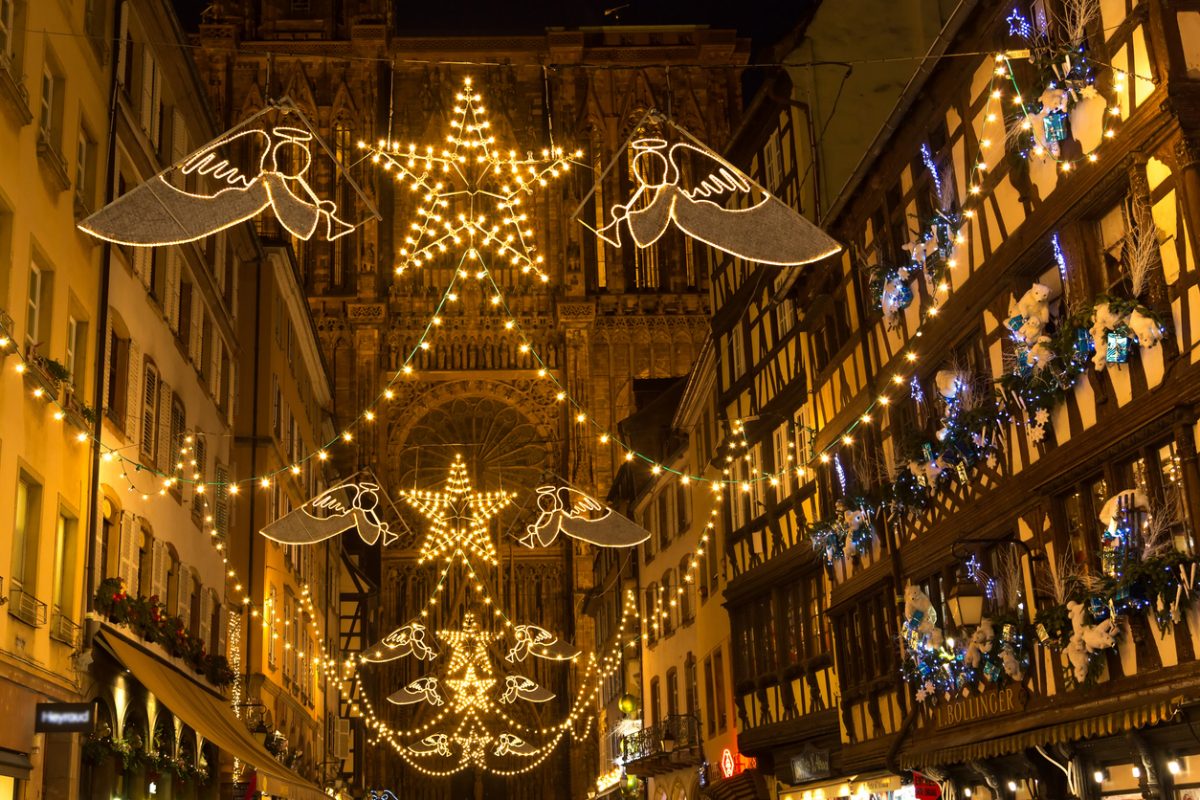Are you planning a trip to France in winter?
From shimmering snow-covered mountains to frost-dusted cityscapes, winter in France transforms the country into a magical wonderland that’s brimming with adventure, culture, and yes, a lot of good food.
I grew up just over the Channel in Kent, and went on countless winter trips to France in my childhood – I’ve also been on a fair few as an adult.
So, what are the best places to visit in France in winter, what are the top winter activities, and how do you prepare for such a trip?
I’ve put all of my best tips on winter travel in France into this blog post.
So get ready to say “Bonjour!” to France in wintertime!
What’s France in winter like?
Winter in France is a time when the vibrant greens of the mountains surrender to the mesmerizing white snow and cityscapes alter their appearance, donned in twinkling fairy lights and resplendent decorations.
Paris, the city of lights, shines brighter than ever.
Its iconic landmarks, like the Eiffel Tower and Notre Dame, are enhanced by frost and glimmer in the low-lying sun.
Venturing beyond the cities, the rural landscapes are equally breathtaking.
Snow-laden fields and frosted trees create picturesque scenes worthy of a postcard.
The French Alps and the Pyrenees, with snow-capped peaks and pristine ski slopes, become a playground for winter sports enthusiasts.
Winter also brings one of France’s most cherished traditions – the Christmas markets (Marché de Noël in French)
Towns and cities across the country, particularly in the Alsace region, host these festive markets, with their quaint stalls offering everything from handmade crafts and decorations to culinary delights like mulled wine, gingerbread, and roasted chestnuts.
And winter cuisine in France takes a hearty turn.
Tables are laden with comforting French dishes like cassoulet, tartiflette, and raclette – dishes designed to warm the soul on frosty winter days!
Bakeries overflow with seasonal pastries and chocolates, their sweet aromas mingling with the crisp winter air.
Cultural events are aplenty, too.
From Nice’s lively Carnival to Lyon’s awe-inspiring Fête des Lumières, the season is full of celebrations, showcasing the richness of French traditions and the joie de vivre of its people.
Weather in France in Winter
French winters can be cold, but they’re also filled with crisp, clear days that are perfect for exploring.
In the north, temperatures range from 0°C to 7°C (32°F to 45°F), while the south enjoys a slightly warmer 7°C to 13°C (45°F to 55°F).
Mountainous regions such as the Alps and the Pyrenees are much colder with heavy snowfall, perfect for any ski and snowboard aficionados.
To give you a very rough idea, here are the average temperatures for different regions in January, the coldest month in France.
| Region | High Temperature (°C) | Low Temperature (°C) | Rainy Days | Snowy Days | Sea Temperature (°C) |
|---|---|---|---|---|---|
| Northern France | 6°C | 1°C | 12 | 2 | 10°C |
| Western France | 11°C | 4°C | 13 | 1 | 12°C |
| Eastern France | 2°C | -3°C | 8 | 18 | – |
| Southern France | 13°C | 6°C | 7 | 0 | 13°C |
| The Alps | 1°C | -5°C | 7 | 17 | – |
Best places to visit in France in winter
So, you’ve decided on France for your European winter vacation.
Excellent! Now, where exactly do you go?
France is the biggest country in Western Europe and there are countless tourist attractions and beautiful cities to explore in the winter months.
I’ve whittled it down to just 25 of my top places!
1. Paris

We had to start somewhere – so why not in the French capital city?
Affectionately known as the City of Love, Paris undergoes a striking transformation in the winter.
Streets once filled with autumn leaves turn into frosty paths, illuminated under the soft glow of thousands of lights.
Christmas markets, a cornerstone of the French holiday season, spring to life in almost every quarter.
From Saint-Germain-des-Prés to La Défense, each market is a treasure trove of holiday delicacies, warm mulled wine, and artisanal gifts crafted with care.
An evening visit to the Eiffel Tower, Paris’s signature landmark, is a must during winter.
The cold, clear nights bring a unique clarity to the view, while the structure’s hourly sparkle against the winter sky is an unforgettable sight.
The Champs-Élysées, known for its grandeur, transforms into a magical sight during winter.
As the festive season approaches, the famed avenue adorns itself with glittering lights and holiday decorations.
After, visit Galeries Lafayette.
The store’s annual holiday window displays are a feast for the eyes, delighting children and adults alike.
If you’re visiting Paris in January or February, the capital offers a warm refuge in its world-renowned museums and cosy Parisian cafés.
A perfect day could begin with a warm croissant and chocolat chaud at a local café, followed by a dive into culture and history at the Louvre or Musée d’Orsay.
And what better way to celebrate Valentine’s Day than in the city of love itself?
Paris in any month is a delight!
2. Strasbourg
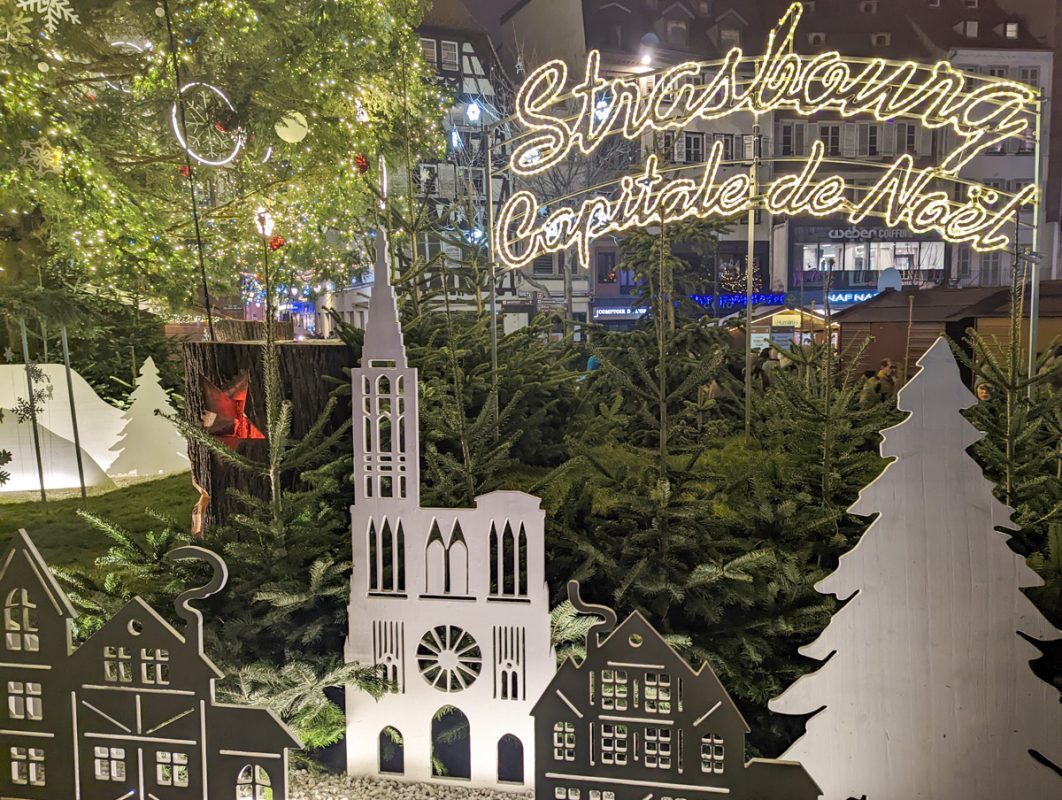
If you’re in France in December, you have to visit the self-proclaimed capital of Christmas!
Strasbourg’s Christkindelsmärik is one of the oldest and largest in Europe.
This bustling hub hosts more than 300 wooden chalets and draws visitors from far and wide with its assortment of traditional crafts and seasonal delicacies.
No visit to Strasbourg would be complete without marvelling at the monumental Christmas tree standing guard beside the striking Notre Dame Cathedral (which is also well worth admiring).
This towering spectacle illuminates the square, creating a dazzling contrast against the Gothic architectural masterpiece.
Just a short walk away, the Petite France district offers a historical panorama of half-timbered houses, their festive decorations mirrored in the city’s icy canals.
Strasbourg’s rich culinary tradition also comes alive in winter.
At traditional Winstub lounges, try regional specialties such as baeckeoffe, a hearty Alsatian stew, and flammekueche, a unique take on pizza layered with cream, onions, and lardons. Pair these dishes with a glass of warm, spiced wine!
There’s no doubt about it, the city of Strasbourg has to be on your France winter itinerary. I visited when I was in Basel, Switzerland in winter (it’s close to the French and German borders) and I’m already working out when I can return!
3. Chamonix-Mont-Blanc
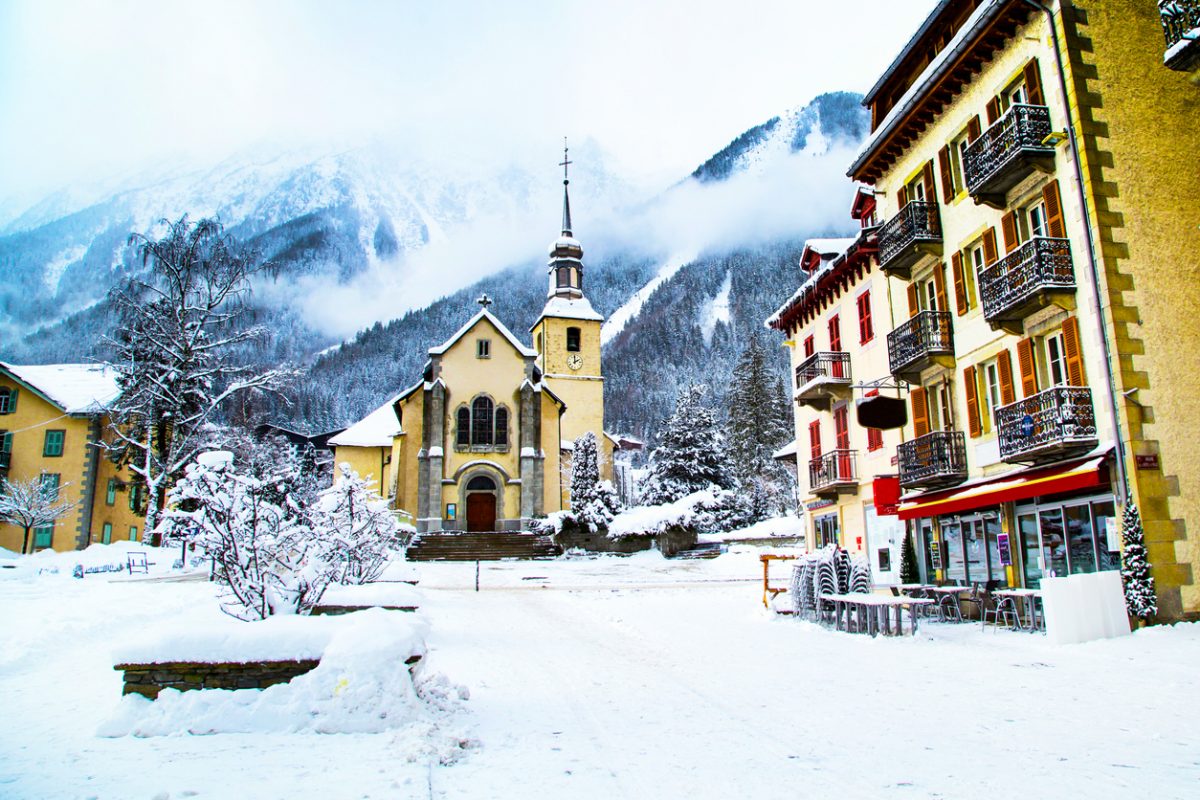
As winter falls over Chamonix, at the foot of the imposing Mont Blanc – the highest peak in Western Europe – the town morphs into a playground for snow lovers.
Its reputation as one of France’s oldest ski resorts is well-earned – I used to go skiing here myself every winter.
One experience that stands above all else is a ride on the Aiguille du Midi cable car.
It scales Europe’s highest mountain peaks, providing an unforgettable panorama of the French, Swiss, and Italian Alps.
If you’re skiing down, it’s part of the Vallée Blanche.
Another must-see is the Mer de Glace. France’s largest glacier paints an incredible picture of nature’s raw power.
The famously bright red Montenvers train will take you there.
For an alternative to the slopes, pay a visit to the Musée Alpin.
This museum houses an extensive collection chronicling the development of Chamonix from a remote mountainous area to one of the world’s most popular winter sports destinations.
After an action-packed day on the slopes, Chamonix town offers a warm welcome.
Many bustling bistros serve vin chaud, a hot, spiced wine that is a favourite winter warmer.
Don’t leave without trying the hearty Savoyard cuisine, a culinary tradition rich in cheese and potatoes.
And once the sun has set, Chamonix doesn’t go to sleep!
Instead, the après-ski scene comes alive and carries on until the early hours.
4. Lyon

Lyon’s reputation for culinary excellence is elevated by traditional bouchons Lyonnais, cosy bistros that exude warmth.
On a chilly winter’s day, the allure of classic dishes like coq au vin, a hearty chicken stewed in red wine, or saucisson chaud, a hot, hearty sausage, is hard to resist.
Complement your meal with a glass of local Beaujolais wine.
December holds a special place in Lyon’s calendar, marking the annual Fête des Lumières.
This tradition, rooted in 1852, transforms Lyon a work of art.
Local artists use the city as their canvas, casting imaginative light installations upon buildings, streets, and parks.
The result is an enchanting nocturnal landscape that pulls in admirers from around the world.
A journey through Lyon wouldn’t be complete without a visit to Vieux Lyon, the city’s historic heart.
Listed as a UNESCO World Heritage site, this district boasts well-preserved Renaissance architecture, imbued with a unique character that deepens under winter’s touch.
While exploring Vieux Lyon, visit the Musée Miniature et Cinéma, a fascinating museum housing miniature scenes and film props, perfect for a cold winter day.
Also, consider a stop at the Lyon Cathedral, a marvel of Romanesque and Gothic architecture, with a magnificent astronomical clock that dates back to the 14th century.
Also, don’t miss Les Halles de Lyon Paul Bocuse.
Named after Lyon’s most famous chef, this indoor food market is a paradise for food lovers, showcasing the best of the region’s products, including cheeses, meats, and pastries.
5. Lille
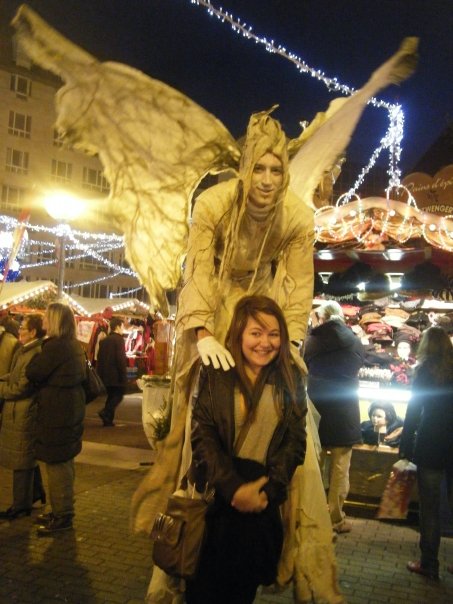

The vibrant city of Lille is known for its annual Christmas market, an assemblage of over 80 chalets that brighten the atmosphere with their selection of local crafts, seasonal indulgences, and warming vin chaud.
I used to visit here on school trips each year!
The market sits in Place Rihour, where a 50-meter-high Ferris wheel stands tall.
Step aboard and be rewarded with a stunning, panoramic view of the city’s festive lights.
Architectural diversity is a standout feature of Lille, where Flemish, French, and modern styles intertwine.
Make sure to stroll through Vieux Lille, the city’s historic quarter and visit Notre Dame de la Treille. This cathedral, with its modern facade and neo-Gothic interior, provides a perfect example of Lille’s blend of traditional and contemporary styles.
There’s also the Palais des Beaux-Arts.
This is France’s largest museum outside of Paris and offers an extensive collection of fine arts, antiquities, and a fascinating medieval and Renaissance collection.
Finally, round off your day with a meal at Le Bloempot.
This restaurant in Vieux Lille features a menu that changes with the season and showcases the best of Flemish and French cuisine.
6. Mont Saint Michel
Mont Saint Michel, a UNESCO World Heritage Site, stands as a testament to architectural ingenuity.
Winter graces this iconic landmark with a unique charm. With the onset of the colder months, the bustling crowds thin out, making way for a more relaxed exploration of this rocky islet.
The heart of Mont Saint Michel, an ancient abbey, is a sight to behold.
In the gentle winter light, its gothic spires, robust walls, and intricate flying buttresses assume an otherworldly aura.
Walking through the snaking, narrow streets that envelop this abbey becomes a journey into a timeless world.
There’s even a chance that you might see Mont Saint Michel with a soft blanket of snow.
The marvel of Mont Saint Michel isn’t limited to the rock and its abbey.
The surrounding landscape, with its ever-changing tides and ethereal winter mists, adds a dramatic flair to the scene.
The bay, known for having some of the highest tides in Europe, is also home to an array of wildlife, especially birds – so don’t forget to pack your binoculars!
A visit to La Mère Poulard, a legendary inn and restaurant established in 1888, should be included in your itinerary.
Famous for its towering, fluffy omelettes, this establishment has been serving visitors for over a century and continues to be a beloved part of the Mont Saint Michel experience!
7. Nice
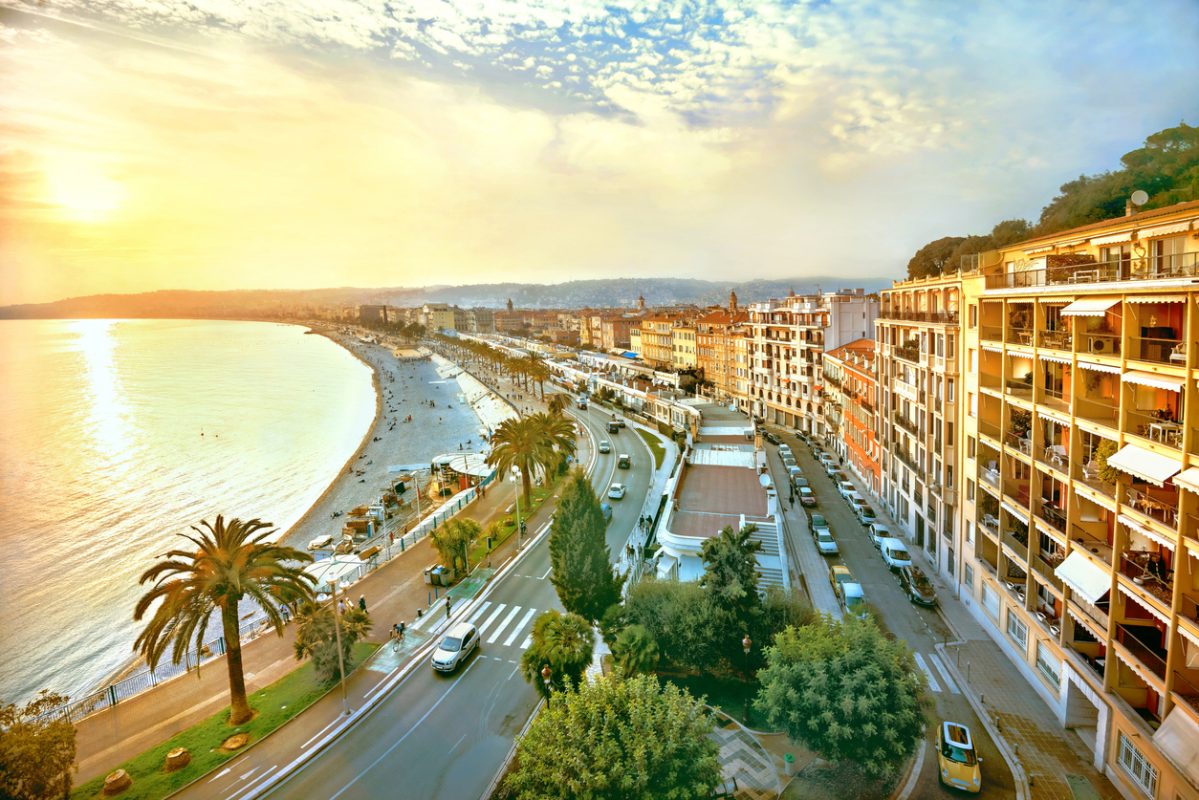
Nice doesn’t surrender to winter’s chill.
Instead, it welcomes the season with a Mediterranean warmth that remains a constant throughout the year.
Its famed Promenade des Anglais, adorned with towering palms, is as inviting as ever.
Although, while there’s fairly warm weather (on a particularly mild day you could call it a winter sun destination!), you probably won’t be sunbathing or swimming.
In February, the city sheds its calm facade to host the Nice Carnival, among the world’s largest.
The city transforms into an exuberant party, brimming with parades, riveting flower battles, and a riot of vibrant costumes.
During this time, visit the Cours Saleya market.
Even in winter, it’s a bustling hive of activity. Here, you’ll find an abundance of fresh produce, a riot of colourful flowers, and an assortment of local crafts.
The market is the perfect place to soak in the local culture and pick up a memento or two of your winter holiday in Nice.
A stone’s throw from the market is Nice’s Old Town, or Vieux Nice. This historic quarter boasts narrow, winding lanes and russet-roofed buildings, with warm, inviting bistros a stark contrast to the crisp winter air outside.
While here, indulge in the flavours of Nice.
Socca, a chickpea pancake, or a robust ratatouille offer a tantalising introduction to Niçoise cuisine.
For those interested in art, a visit to the Musée Matisse, located in the Cimiez neighbourhood, should be on your agenda – as the name suggests, this museum houses a vast collection of works by Henri Matisse and is located in a 17th-century Genoese villa set amidst an olive grove – how very scenic!
8. Annecy
Annecy, known as the “Venice of the Alps,” is home to a network of canals that crisscross the town, framed by pastel-hued houses and set against the grandeur of snow-blanketed Alps.
It looks like it belongs on a holiday card!
The Old Town, with its cobblestone lanes and vibrant markets, beckons you to immerse yourself in its charm.
Winter ushers in a transformation of Lake Annecy, thought to be as Europe’s cleanest lake.
Bonlieu is home to Europe’s largest open-air ice rink; here, you can twirl and glide with the panoramic vista of snow-dusted mountains as your backdrop.
Also, don’t miss the historic Palais de l’Isle. This 12th-century castle was built as a fortress to defend the town.
And if you’re a food enthusiast, make a beeline for the restaurant La Ciboulette.
This Michelin-starred restaurant serves up exquisite renditions of traditional French cuisine.
Opt for a dish with local Reblochon cheese for a truly Savoyard experience!
9. Reims

Reims, often called the capital of the Champagne region, also sparkles in the winter months!
The city, situated in the heart of wine country, is home to prestigious Champagne houses, including Taittinger and Veuve Clicquot.
These establishments welcome visitors with guided tours and tastings that invite you to uncover the secrets of this world-renowned sparkling wine.
To fully embrace the region, raise a glass and toast to the holiday season in the very birthplace of champagne.
Here’s an insider’s tip – =book a champagne pairing dinner at a local restaurant, such as Le Millénaire, to really understand and savour the complexities of this celebratory drink.
While the champagne is certainly the star of the show, Reims has more to offer.
The Reims Cathedral, a pinnacle of Gothic architecture where French kings were once crowned, stands proud and majestic.
Just a stone’s throw from the cathedral, the annual Christmas market takes place.
Here, vendors fill their stalls with a medley of crafts, regional delicacies, and naturally, bottles of local champagne!
10. The Loire Valley
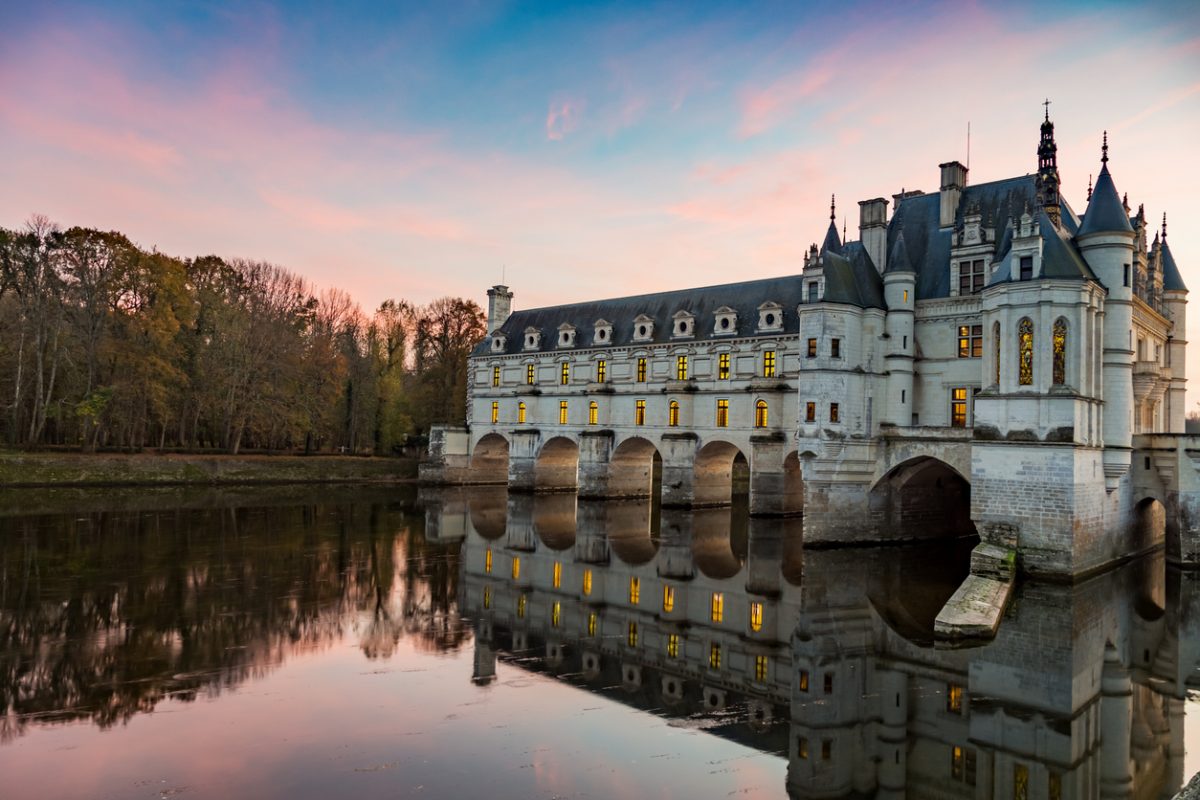
The Loire Valley, referred to as the “Garden of France,” is a timelessly romantic French winter destination!
As winter cloaks the region, the stunning châteaux and expansive vineyards transform into a quiet, ethereal landscape.
The elegant Château de Chenonceau, arching gracefully over the Cher River, and the awe-inspiring Château de Chambord, known for its distinctive French Renaissance architecture, are among the best castles to visit in the region.
During the holiday season, many of these châteaux take on an even more magical atmosphere, hosting Christmas events that showcase traditional decorations, festive markets, and often, a hearty dose of French holiday cheer.
For wine aficionados, the Loire Valley is a veritable haven.
While winter may seem like a dormant period, it’s actually an excellent time to explore the region’s vineyards.
These vineyards, lying low in the cool season, are responsible for some of France’s most lauded wines – and the quieter season is the best time to explore!
11. Eguisheim
The quaint village of Eguisheim, in the heart of Alsace’s celebrated wine region, is renowned for its charm, often securing its spot among the most picturesque villages in France.
The village’s unique, concentric cobblestone streets become even more enchanting in the winter months.
Half-timbered houses, awash in a riot of colors, stand side by side, their facades adorned with twinkling fairy lights and festive decorations.
A highlight of Eguisheim in winter is its annual Christmas market, making December the perfect time to visit.
Here, you can browse an array of stalls selling traditional Alsatian Christmas ornaments.
Foodies will find plenty to savour here – vendors offer a selection of regional delicacies.
Try a freshly baked bretzel, a type of soft pretzel, or indulge in some pain d’épices, a richly spiced local gingerbread and holiday staple!
Of course, no visit to Eguisheim would be complete without a taste of the region’s celebrated wines.
Alsace is particularly famous for its aromatic white wines, such as Riesling and Gewürztraminer. In the chill of winter, you might want to sample a glass of Vin Chaud, a warm mulled wine made with local vintages.
For a panoramic view, climb up to the castle ruins of Château du Hohlandsbourg.
Located just outside Eguisheim, it offers an unrivalled view over the snow-capped roofs of the village and the vineyards beyond.
12. Les Arcs
In the heart of the Tarentaise Valley, Les Arcs is a haven for winter sports enthusiasts.
The ski resort offers a myriad of runs that cater to a range of skill levels, from snow sports novices to seasoned pros.
The expansive, interconnected ski domain it shares with La Plagne, known as Paradiski, is one of the largest in the world.
Off-piste enthusiasts can carve their way through fresh powder, while the varied blue and red runs are perfect for intermediate downhill skiing.
The resort also boasts well-equipped areas for beginners.
Don’t fancy skiing? Les Arcs offers an array of alternative outdoor activities in winter.
Experience the thrill of dog sledding as you glide through snow-laden forests, or strap on a pair of snowshoes and take a walk!
For those seeking an extra dose of adrenaline, there’s the opportunity to try ice climbing or hurtle down Europe’s longest toboggan run.
Once you’ve had your fill of winter sports, take a break in one of the many mountain restaurants dotted around the slopes, where you can savor hearty Savoyard fare like fondue and raclette.
Après-ski culture is strong here too!
13. Colmar
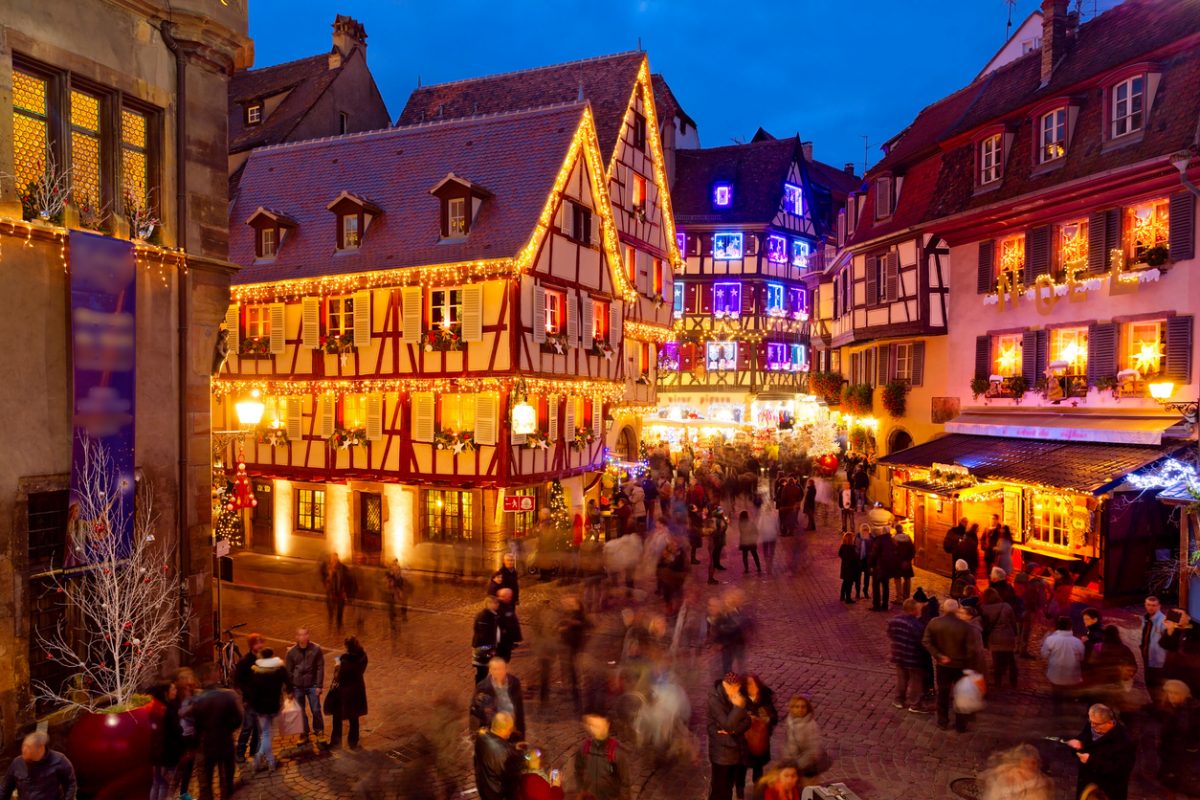
The Alsatian town of Colmar, close to the German border, fully embraces the winter season.
As temperatures drop, the vibrant old town transforms.
The town’s canal system, known as Little Venice, weaves around cobblestone streets and timber houses.
As Christmas approaches, Colmar unveils one of France’s – and Europe’s – most renowned Christmas markets.
This festive extravaganza spans six different locations within the town, each brimming with a myriad of stalls.
These markets offer the perfect opportunity to sample local delights. Sink your teeth into a flammekueche, an Alsatian pizza with a thin, crispy base and a creamy topping, or warm up with a glass of mulled white wine.
I visited Colmar last November – the weekend when the festive markets opened – and loved the atmosphere.
Are you an art fan?
A winter visit to Colmar would be incomplete without exploring the Unterlinden Museum.
This former convent turned cultural hotspot houses a vast collection of art, with its star attraction being the Isenheim Altarpiece, a masterful piece of German Renaissance art.
If you’re visiting outside of the festive season, Colmar’s streets are quiet, yet its beauty is ever-present.
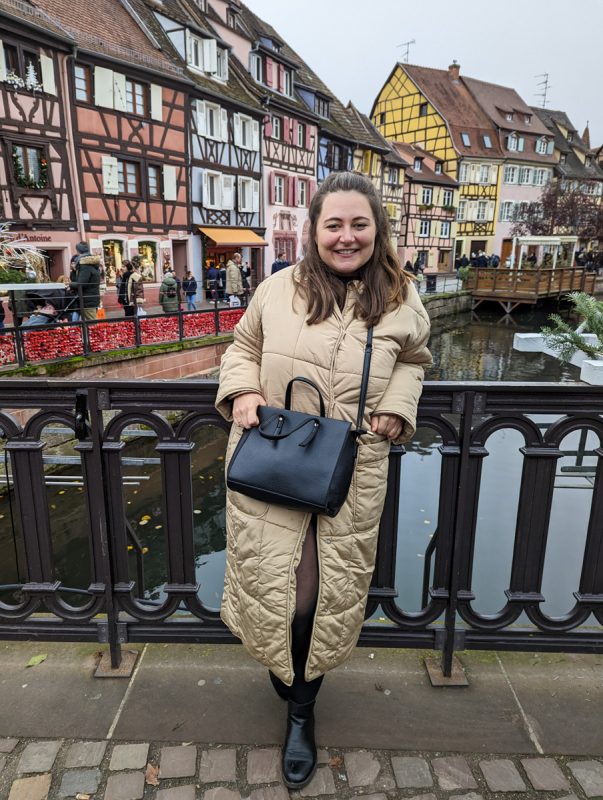
14. Biarritz
Biarritz, a swanky seaside town in the French Basque country, is famous for its extensive sandy beaches and formidable surf.
In fact, it’s a hub for water sports enthusiasts even during the colder months.
If surfing in winter isn’t for you (it should be attempted by pros only!) a brisk walk along the renowned Grande Plage, looking at the rough waves and the hardy surfers, is a refreshing alternative.
Post-stroll, warm up with a cup of hot chocolate in one of the inviting beachside cafés.
Visit the Rocher de la Vierge, a famous local landmark topped with a statue of Virgin Mary.
This rocky outcrop, accessible by an iron bridge, boasts sweeping views of Biarritz and the powerful Atlantic Ocean. It’s a particularly mesmerizing spot during the winter months when the ocean is at its wildest!
Winter is also an ideal time to appreciate Biarritz’s relaxed vibe, with fewer tourists around.
Enjoy exploring the town at your own pace – browse through the city’s fashionable boutiques and discover the striking Art Deco architecture.
You could even try some fresh catch at one of the town’s best seafood restaurants.
Don’t miss a visit to the Biarritz Lighthouse.
The panoramic view of the town, with its twinkling winter lights and the ocean’s expanse, is well worth the climb up the 248 steps.
15. Bordeaux
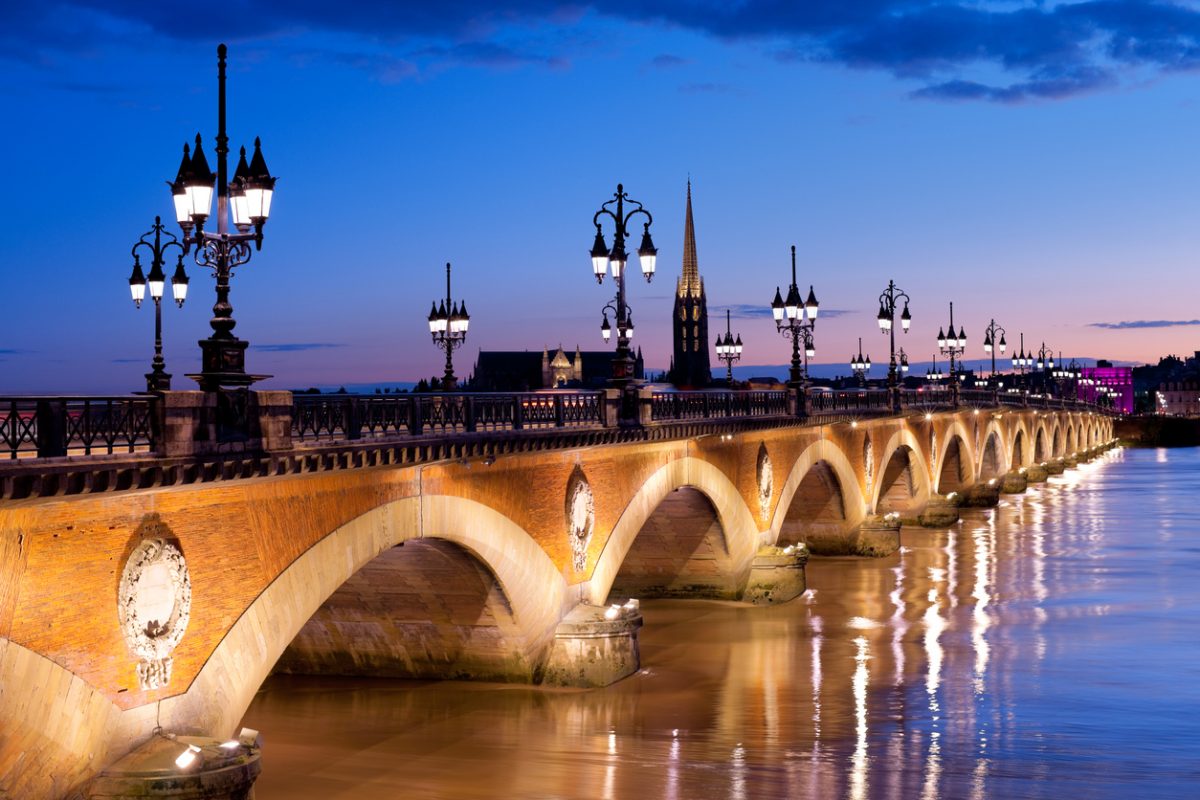
Bordeaux, a city celebrated for its exceptional wines, is wonderful in winter.
Venture into the city’s historic vineyards and renowned wine châteaux, where you can partake in tours and tastings. Winter does not impede the flow of fine Bordeaux wine – it’s a year-round experience!
Aspiring wine connoisseurs can also expand their knowledge by taking a course at the Bordeaux Wine School.
The city’s passion for wine is contagious, and these classes offer a deep dive into the art of wine tasting and the complexities of Bordeaux’s wine production.
In the heart of the city, the Bordeaux Christmas market is ever-popular during the holiday season.
Place de la Bourse, one of the city’s most significant squares, is also wonderful during winter.
Another top attraction is the Cité du Vin, a contemporary building resembling a coiled vine, rising from the banks of the Garonne River.
This unique museum offers an immersive and interactive journey through the history and culture of wine.
16. Rouen
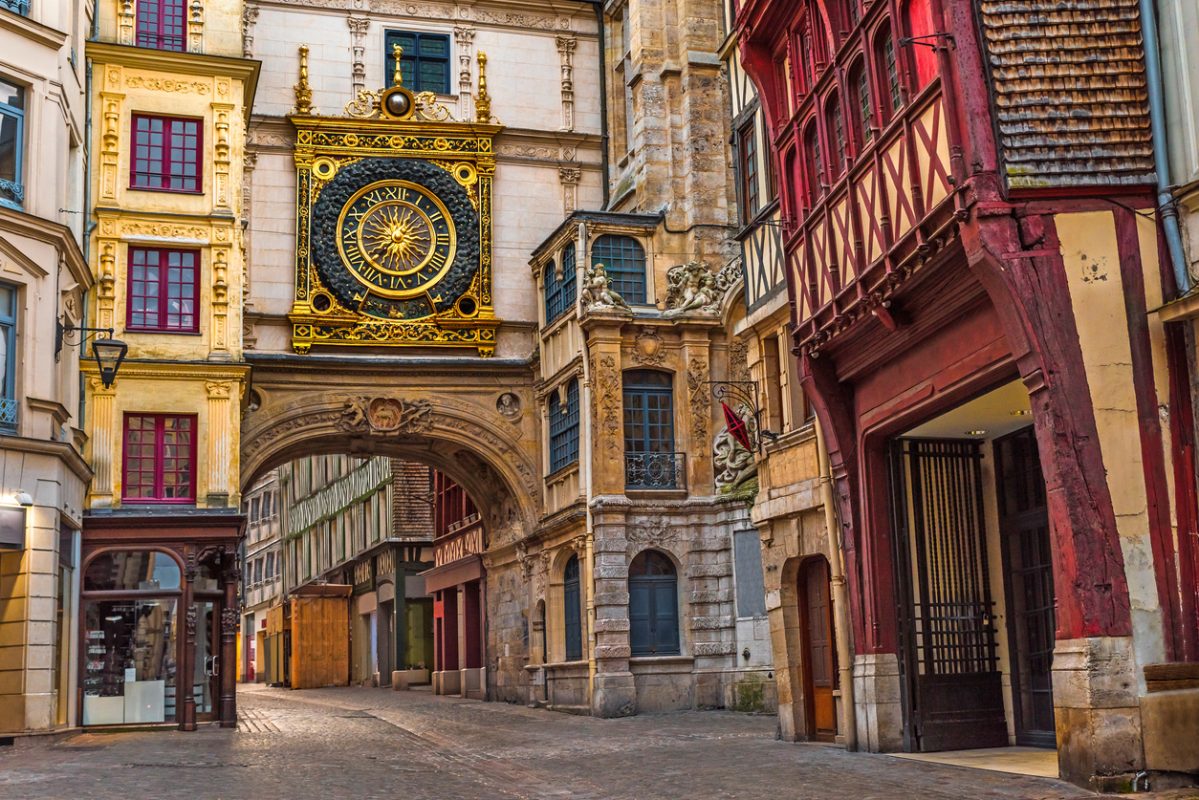
Winter embraces Rouen, as the medieval old town, punctuated by half-timbered houses and paved with cobblestones, is frosted in a delicate layer of ice – and potentially snow.
Standing tall amidst this vintage scenery is Rouen Cathedral. The Gothic cathedral, a muse that spurred Monet’s creativity, casts a majestic silhouette against the winter sky.
While wandering the medieval town, don’t miss the Gros Horloge, a 14th-century astronomical clock that still works today.
And check out the Place du Vieux-Marché, the site of Joan of Arc’s martyrdom.
Today, it’s a bustling square where market vendors rub shoulders with cafés.
In winter, these spots offer a respite from the chill, serving steaming cups of coffee and hearty Norman cuisine.
17. Metz
In the northeastern reaches of France lies the wonderful city of Metz.
Metz’s defining feature, its imposing Cathedral, rules the skyline.
With 6,496 square meters of stained glass, the cathedral is a blaze of colour even on the greyest of winter days.
As you navigate the city’s charismatic streets, you’ll encounter an array of styles – from medieval fortifications and German Imperial structures to contemporary French designs.
Each corner turned unveils a new narrative of the city’s diverse cultural heritage.
Metz lays claim to France’s largest Christmas market, a winter event that brings the city to life with a unique blend of holiday traditions.
Over 130 chalets materialize across the city’s plazas, their wooden structures brimming with handcrafted gifts and regional gastronomy.
Particular highlights are the ice rink and the city’s festive Ferris wheel.
As it ascends, it affords an unparalleled view of Metz’s cityscape, bathed in the soft glow of Christmas lights.
18. Grenoble
Situated majestically at the foot of snow-capped mountains, Grenoble is frequently referred to as the “Capital of the Alps“.
This moniker is well deserved, as Grenoble boasts a strategic location that offers an immediate springboard to some of the most prestigious ski resorts in the French Alps.
The promise of carving through fresh powder draws many to this city when the snow starts to fall.
Yet, the allure of Grenoble extends beyond the thrill of winter sports.
The city itself teems with cultural and historical treasures, including the Bastille, an intricate network of ancient fortifications that tell tales of the city’s past.
The Museum of Grenoble showcases an impressive assembly of art representing diverse periods and styles.
Once you’ve finished, take the time to meander through Grenoble’s streets, where buildings narrate the city’s evolution through their architectural styles.
19. Dijon
Most famous for its fiery mustard, Dijon also boasts immense architectural beauty, with an impressive collection of pristine medieval and Renaissance structures.
Embark on a journey through time as you follow the footsteps of the Owl’s Trail.
This pathway escorts you past an array of the city’s most emblematic historic sites.
Among these is the imposing Palace of the Dukes of Burgundy. Elsewhere, clusters of charming half-timbered houses reveal stories.
The lure of Dijon extends beyond the city’s boundaries.
Located in the surrounding countryside are the legendary vineyards of Burgundy, the birthplace of some of the most esteemed wines on the planet.
Visit the vineyards, meet local producers, uncover the secrets of the wine-making process, and indulge in a wine-tasting session, the vintages even more enjoyable in the crisp winter air.
Oh, and try some beef bourguignon – it hails from the area!
20. Val d’Isere
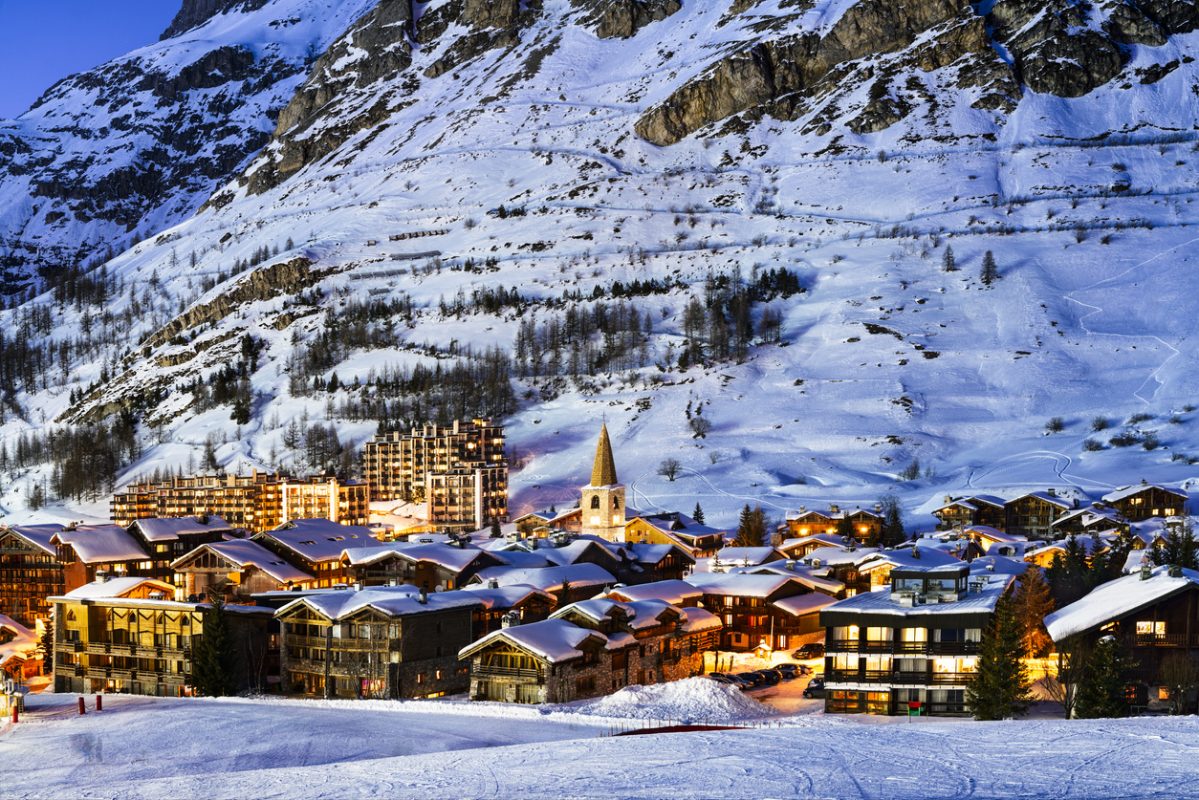
Perched in the Tarentaise Valley, Val d’Isere is a popular Alpine town.
It’s revered on the global stage for its exceptional skiing credentials, offering a reliable abundance of snowfall that transforms the landscape into a white canvas for winter sports.
Val d’Isere’s expansive ski terrain invites enthusiasts of all levels.
Whether you’re a tentative beginner making your first foray onto the slopes or a seasoned expert ready to carve a path down challenging runs, the resort caters to a spectrum of abilities.
Connected to the Espace Killy ski area, the resort unlocks over 300 kilometers of diverse ski runs.
As your day of winter sports draws to a close, descend into the heart of the resort, where a traditional alpine village awaits.
The sight of cosy chalets, roofs laden with snow, greets you at every corner, while high-end boutiques offer a selection of luxury retail therapy.
A medley of international and French restaurants cater to hungry skiers.
And when the night descends on Val d’Isere, the vibrant après-ski scene erupts into life!
21. Aix-en-Provence
Heading to the sun-dappled South of France, Aix-en-Provence ushers in the winter months subtly, retaining its mild climate.
Winter’s a quiet time to visit Aix-en-Provence; meaning you can enjoy the wonderful architecture in peace!
Saunter down Cours Mirabeau, one of the city’s main thoroughfares, and enjoy fountains and cafés spilling their warmth onto the sidewalks, the tantalizing aroma of fresh coffee hanging in the air.
There’s a weekly market throughout the winter, where stall owners showcase their regional produce, unique antiques, and finely crafted wares.
In the heart of the city lies the Saint-Sauveur Cathedral, an emblem of the city’s rich religious heritage.
Its intricate architecture is a visual narrative that spans from the 5th to the 17th centuries, making it a feast for the eyes and a journey through time.
A different kind of artistic legacy awaits at Atelier Cézanne, a testament to the creative genius of Paul Cézanne.
This is where the master spent his days immersed in painting, shaping the masterpieces that would cement his name in art history.
Fancy chilling out? Thermes Sextius is a popular spa, established upon the city’s ancient Roman hot springs.
22. Toulouse
Toulouse, or the ‘Pink City’ as it’s fondly called, owes its distinctive nickname to the red brick facades that bathe the city in warm hues.
When winter descends, the city takes on an even more enthralling appearance.
Majestically dotting the city’s skyline, Toulouse’s churches combine architectural beauty and historical resonance.
The Basilique Saint-Sernin‘s bell tower is an iconic symbol of the city.
The Jacobins Convent, with its beautiful cloister and remarkable ‘palm tree’ vault, offers an oasis of tranquillity.
The heart of Toulouse is the Place du Capitole, a grand square that bursts into a flurry of activity during the festive season.
A traditional Christmas market takes residence here, its twinkling lights reflected on the cobblestones.
Stroll among the stalls, each one a treasure trove of unique gifts and regional specialities.
Savour the sweetness of candied fruits, the crunch of roasted chestnuts and the spiciness of gingerbread.
23. Riquewihr
In the heart of Alsace, along the famed Wine Route, lies Riquewihr, a medieval town that looks like it’s jumped straight out of a storybook.
This enchanting settlement, framed by undulating vineyards and fortified walls, is beloved for its timeless charm.
At the heart of the village, Rue du Général de Gaulle pulses with life and activity.
You can step into Riquewihr’s past by visiting the 16th-century Maison de Vigneron (winemaker’s house) which showcases winemaking tools, the Dolder Belfry with the Musée du Dolder’s ancient weapons, and the Tour des Voleurs which has chilling torture instruments!
Every year, the anticipation of the festive season is marked by the arrival of the Christmas market. This annual celebration may be small in scale, but it’s brimming with charm.
Under the twinkle of holiday lights, wooden chalets showcase an array of handcrafted goods that make perfect gifts or keepsakes.
Here, too, the region’s viticultural heritage shines, with the opportunity to sample the renowned Alsatian wine!
24. Chartres
Just one hour from Paris, Chartres is famous for the Cathedral of Notre Dame of Chartres.
This architectural tour de force towers over the town, its stone spires reaching for the crisp winter sky.
Often bathed in the soft glow of winter’s low-lying sun, the cathedral’s façade presents a harmonious blend of Romanesque solidity and Gothic grandeur.
Step inside, and you’ll be awed by the exquisite array of stained glass windows, their colors dancing in the soft light, painting tales of biblical narratives and bygone eras.
As winter deepens, the town embraces the festive spirit, illuminating the nights with thousands of twinkling lights.
These lights bedeck the town’s buildings and streets, casting a soft glow on the cobblestones and historic architecture, and transforming Chartres into a mesmerizing spectacle of light and shadow.
Venture into the charming old town, and you’ll be welcomed by a labyrinth of narrow streets, lined with well-preserved medieval and Renaissance buildings.
25. Avignon
In the heart of Provence, the historic city of Avignon still seems a monument to a bygone era when it served as the center of Christendom in the 14th century.
Dominating the city skyline is the Palais des Papes, an awe-inspiring testament to Avignon’s past as the seat of the Catholic Papacy.
This fortress-like palace, replete with towering turrets and formidable stone walls, stands as a stark reminder of the ecclesiastical power that once resided within.
During the winter months, you can meander through its expansive rooms, chapels, and courtyards at leisure.
Nearby, the remnants of the Saint-Bénézet Bridge, more commonly known as the Pont d’Avignon, arch gracefully over the Rhône River.
Avignon’s enchanting old town is a labyrinth of cobbled streets and charming squares.
Under the cool winter sky, these streets assume a quiet charm as the golden stone buildings glow warmly against the crisp air.
Modern Avignon’s a dynamic city with a vibrant arts scene and even during winter, you can experience this creative spirit in the city’s numerous museums, art galleries, and theaters.
Finally, a visit to Avignon would be incomplete without sampling the local Provencal dishes.
Warm up in a local bistro with a comforting bowl of daube provencal, a rich beef stew, or try the local winter delicacy, black truffle, known as ‘black diamonds’.
What to pack for France in winter
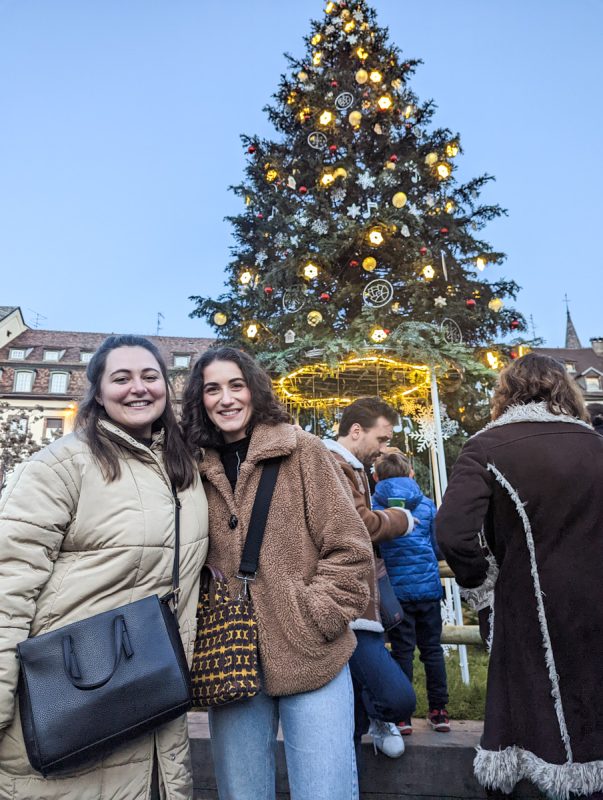
Pack for comfort and style!
First, remember the essentials: a warm, waterproof coat, layers for variable temperatures, a chic scarf (you’re in France after all!), comfortable walking shoes, and a sturdy umbrella.
Cold weather accessories like gloves and a woolly hat are a must, as they will provide much-needed warmth during those chilly winter days and nights.
Additionally, don’t forget to pack some warm socks – not only will they keep your feet toasty, but they can also add an extra layer of cushioning during long days of exploration.
Considering the dry winter air, it’s a good idea to pack skincare essentials like a rich moisturizer, lip balm, and hydrating face masks to prevent your skin from drying out. A travel-sized hand cream can also come in handy when you’re out and about.
If your itinerary includes a trip to the French Alps or other ski areas, you’ll need to pack appropriate ski gear, including ski pants, goggles, and thermal wear. However, if you prefer not to carry these bulky items, most ski resorts offer equipment for rent.
Don’t forget the chargers and consider bringing a portable power bank for on-the-go charging.
Also, if you plan on using your phone outdoors extensively, a touchscreen-friendly pair of gloves could be very useful.
Lastly, although France is known for its fashion, remember that comfort should be your priority, particularly in winter!
While a pair of stylish boots might be tempting, opt for footwear that’s warm, comfortable, and water-resistant.
Considerations for visiting France in Winter

- Weather Conditions: France’s winter weather can vary greatly depending on the region. Northern France, including Paris, can experience cold, rainy winters with occasional snow. The French Alps and other mountainous regions are known for heavy snowfall, ideal for winter sports enthusiasts but demanding extra precautions for travel safety. Southern France generally enjoys milder winters but can still be quite chilly. Always check the local forecast and plan your activities accordingly.
- Packing Appropriately: As already discussed, packing for winter in France requires thoughtful preparation. Warm, waterproof clothing, comfortable footwear, and skin care products to combat the dry winter air are just some of the essentials.
- Daylight Hours: Winter days in France are much shorter. Sunset can occur as early as 5 p.m., which may impact your sightseeing plans. Try to start your day early to make the most of the daylight.
- Holiday Season: December in France is a festive season marked by Christmas markets, special events, and holiday decor. This can be a wonderful time to visit but also a busy one, particularly in popular cities like Paris and Strasbourg.
- Transportation: Winter weather can affect travel plans, particularly in regions prone to snow. Trains and flights might face delays or cancellations. When planning day trips or moving between cities, it’s essential to factor in potential weather-related disruptions. If you’re travelling during peak times, I’d recommend booking your train tickets in advance (Trainline works in France).
- Winter Sports: If your plans involve winter sports like skiing or snowboarding, remember that safety should be a priority. Ensure you have the appropriate gear and insurance coverage, and always adhere to the safety guidelines provided by your chosen resort.
- Off-Season Benefits: One of the great benefits of visiting France in winter is the lack of crowds at major tourist sites. However, keep in mind that some attractions may have shorter winter opening hours or be closed for maintenance. Always check opening times in advance.
- Indoor Activities: While France’s outdoor attractions may draw you in, don’t overlook the wealth of indoor activities available. Museums, galleries, theaters, and restaurants provide enjoyable experiences and respite from the cold.
- Health Precautions: Cold weather can sometimes lead to health issues such as colds or flu. Make sure to prioritize your health: keep warm, stay hydrated, and consider travel insurance that covers medical expenses.
Visiting France in winter FAQs
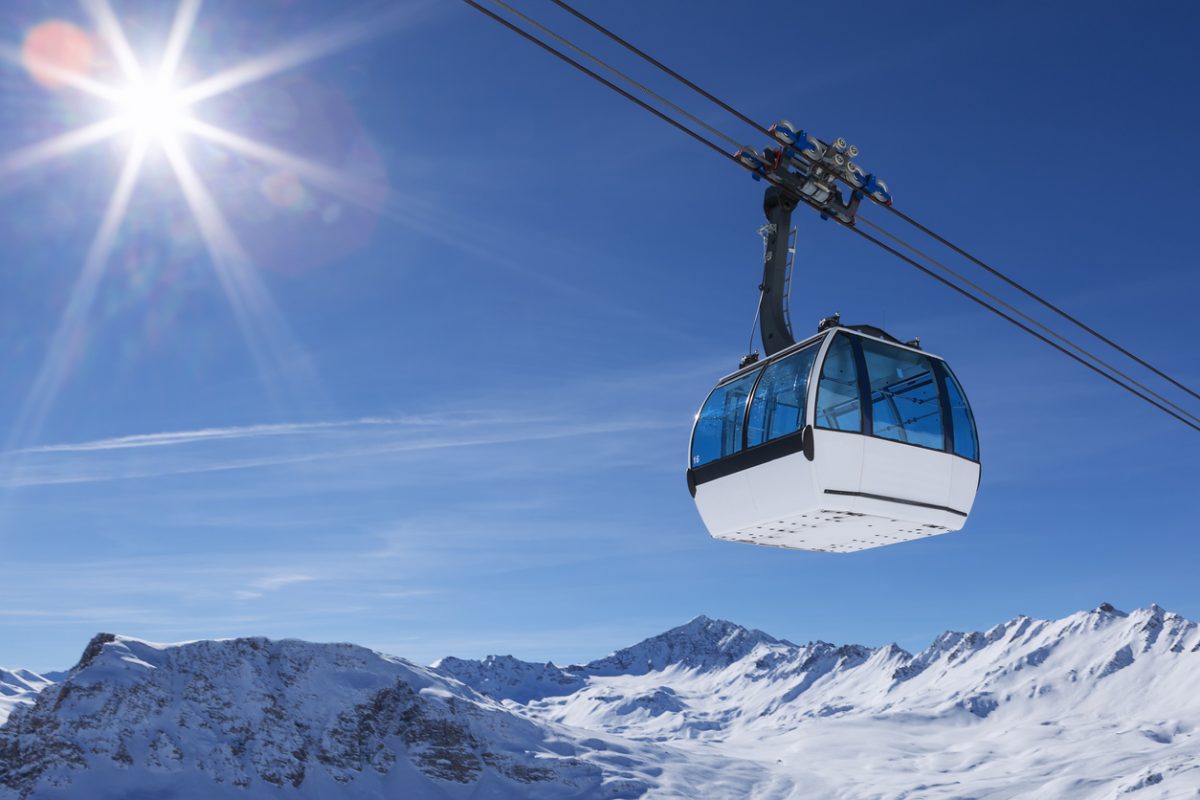
Is it worth visiting France in winter?
Absolutely! A winter break in France offers a unique charm with fewer crowds, picturesque landscapes, festive Christmas markets, and snow-covered mountain ranges for skiing. Cities such as Paris, Strasbourg, and Lyon are lit up with beautiful holiday lights, and the winter food and drink are delightful.
What is France like in winter?
France in winter can range from mild to cold, depending on the region. Northern and Eastern parts of the country often experience frost and occasional snow, while the South has milder temperatures. France’s winter is characterized by holiday decorations, festive markets, and various winter activities, especially skiing in the Alps.
Where in France is good in winter?
Many places in France are wonderful in winter. Paris is magical with its festive lights and holiday markets. Strasbourg and Colmar in Alsace are famous for their Christmas markets. The French Alps, including Chamonix, Courchevel, and Val d’Isere, are excellent for winter sports enthusiasts.
Is it worth it to go to France in December?
Absolutely, December in France is a time of festive celebrations and beautiful holiday decorations. You can enjoy the renowned Christmas markets, particularly in Alsace, indulge in festive foods and drinks, and visit iconic sites without the heavy tourist crowds of summer.
Is France or UK colder?
On average, France experiences colder winters than the UK due to its larger range of climate zones. The northern regions of France have a similar climate to the UK, while the mountainous regions of the Alps and the Pyrenees see much colder temperatures and heavy snowfall.
Where is the warmest part of France in December?
The warmest part of France in December is typically the French Riviera (Côte d’Azur), including cities like Nice and Cannes. These coastal areas of the Mediterranean have a mild winter climate, with average highs around 13-15°C (55-59°F).
Where is the warmest part of France in winter?
Similar to December, the warmest part of France in the overall winter months remains the French Riviera (Côte d’Azur). This region experiences milder temperatures and more sunshine compared to the rest of the country during this period.
Is anywhere in France warm in winter?
Relative to the rest of the country, the southern region of France, particularly the French Riviera, remains warmer in winter. However, “warm” is subjective, as the winter temperatures here typically range from 8-15°C (46-59°F) – pleasant, but not hot. If you’re looking for warmer destinations, I’d recommend checking out Spain in winter.
Where is the warmest place in France at Christmas?
The warmest place in France at Christmas tends to be the French Riviera, including cities like Nice and Cannes. This Mediterranean region enjoys milder winter weather and more sunshine than much of the rest of France.
What is the weather like in France at Christmas?
The weather in France at Christmas can vary widely. Northern and Eastern regions often experience frost and possibly snow, with temperatures hovering around 0-5°C (32-41°F). Southern and Western regions, including the French Riviera, are milder, typically with temperatures between 8-15°C (46-59°F).
Is southern France cold in winter?
Southern France, particularly along the Mediterranean coast, tends to have milder winters compared to the rest of the country. However, temperatures can still drop to around 8°C (46°F), which might be considered cold to some. It rarely snows in this region.
Are you ready for your winter trip to France?
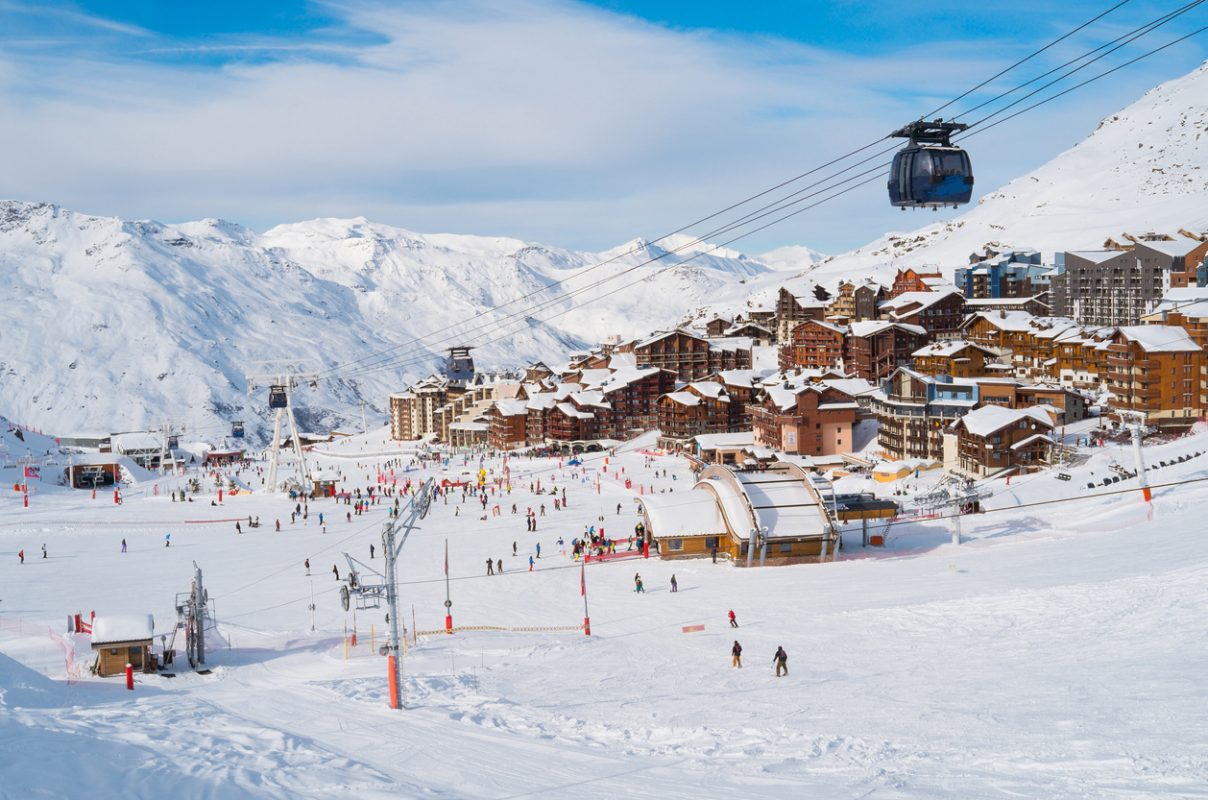
Whether you want to enjoy snowsports in the mountains, mild temperatures in the south, or Christmas markets in the Alscase, there’s so much on offer in a French winter.
So, what are you waiting for? Book your flight tickets and get set for a winter to remember in France!

